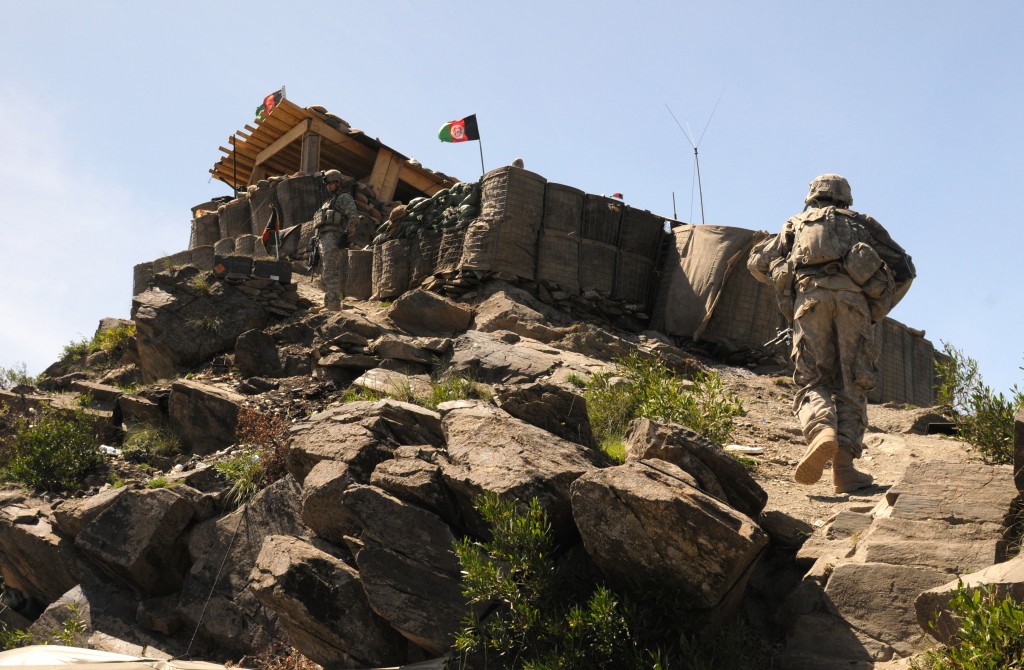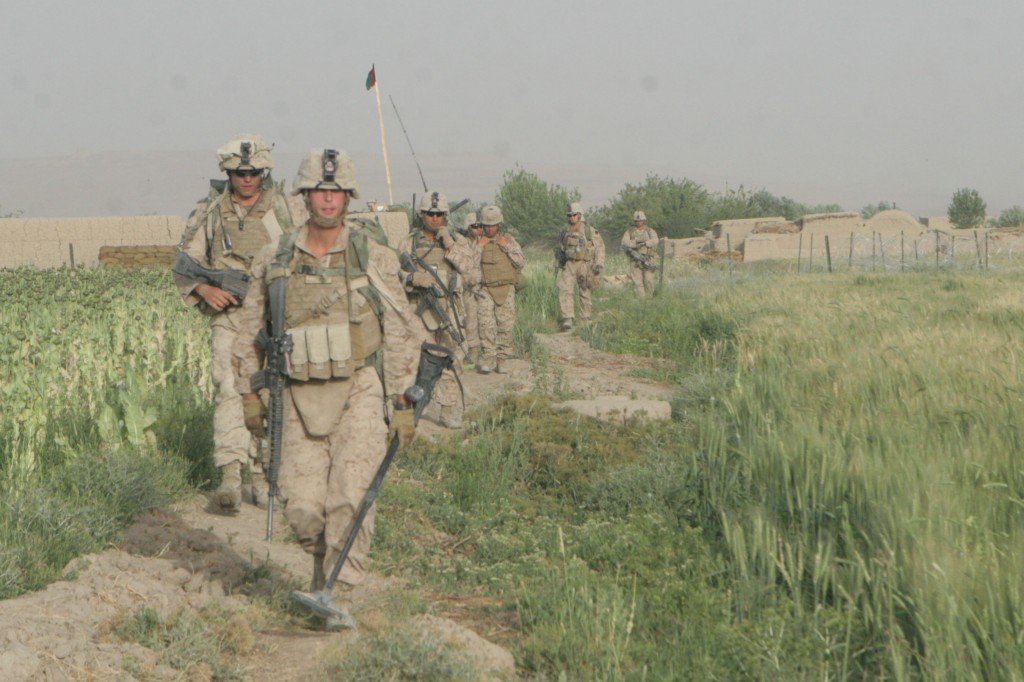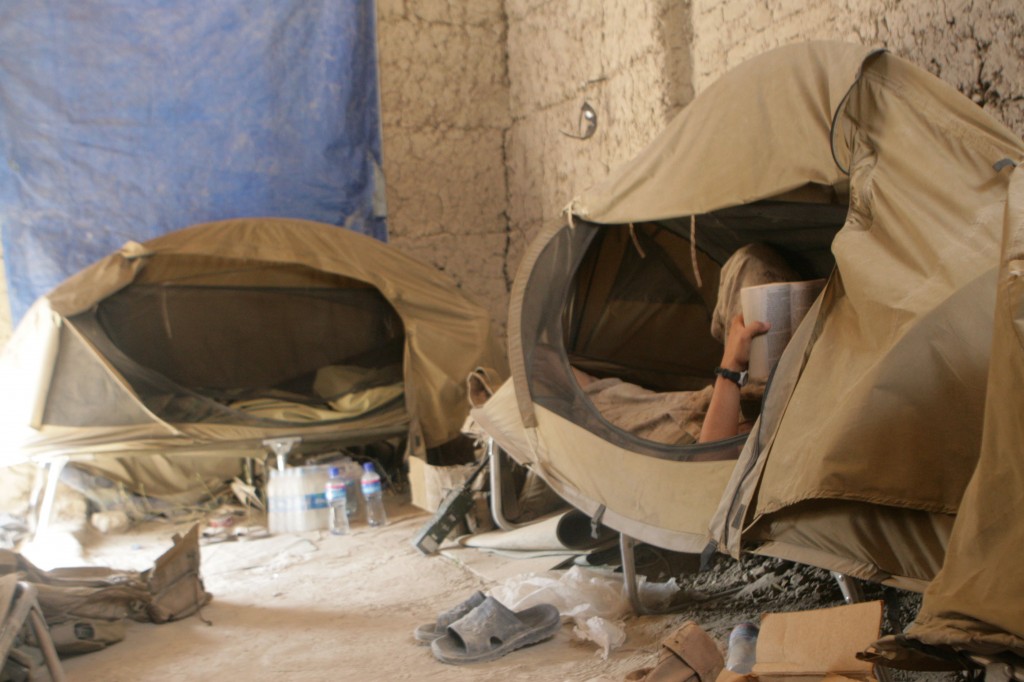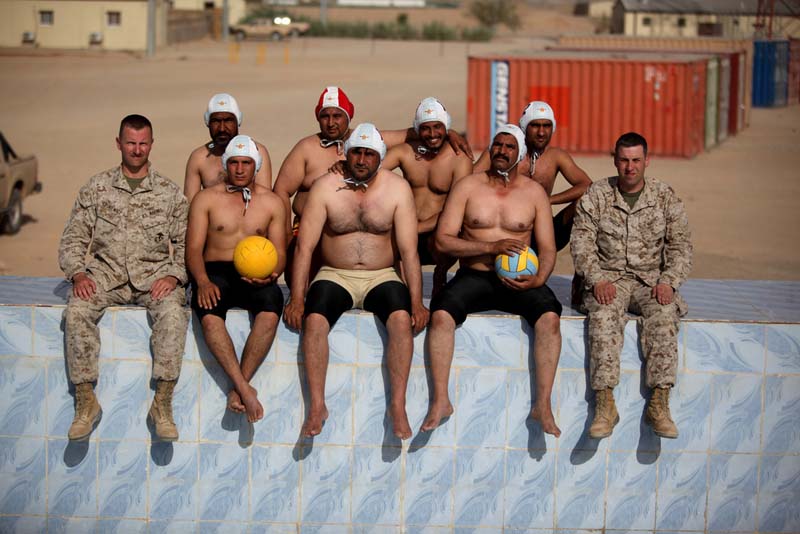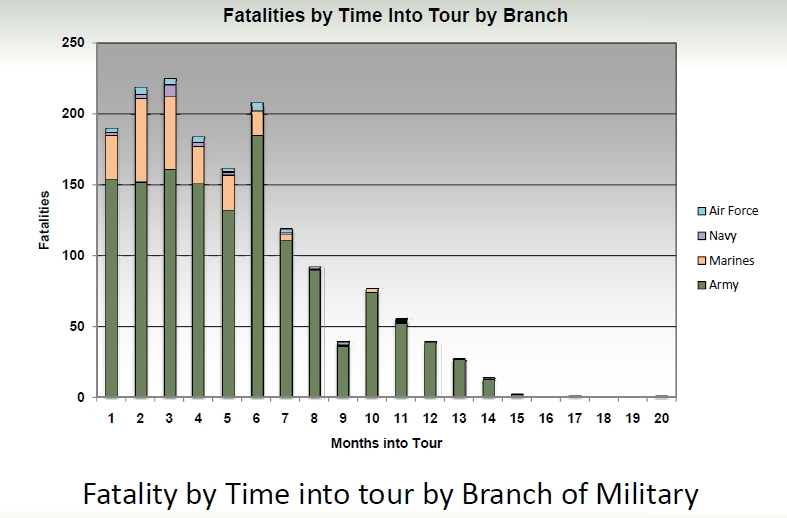COIN zeal grips Afghanistan.
The young governor of Yousef Khel district in eastern Afghanistan takes US Army Lieutenant Marcus Smith by the hand and leads him down a slippery slope.
“Partnership,” Smith says, as the two walk hand-in-hand over churned-up wheat fields, repeating the message at the heart of the strategy he is trying to implement in the small outpost he commands in Paktika province.
A determination to implement US and NATO commander General Stanley McChrystal’s counter-insurgency strategy is evident among the soldiers in this part of Afghanistan.
At bases across the east, inverted pyramids and intricate flow charts are tacked to walls and scrawled on white boards, with slogans such as: “The population is the centre of gravity.”
Up mountains and through valleys, soldiers on patrol muse on historical counter-insurgency campaigns and the writings of Che Guevara or Mao Zedong, trying to find analogies for their modern war.
“We came in with a counter-terrorism strategy specifically to remove the Taliban,” said US Army Major Steven Bower, an intelligence officer for the eastern Afghan provinces of Khost, Paktika and Paktya.
“You have to transition into a strategy that looks, smells and tastes like counter-insurgency — you’ve got to provide security, you’ve got to build capacity and government.”
[ … ]
But implementing the plan creates problems, too.
In some remote areas there is no government partner. In others, local leaders are too young and inexperienced to have any influence. Rookie Afghan police and army lock horns, while wary tribal elders refuse to cooperate.
Militants are attacking development projects while money is frequently skimmed in the corruption-riddled nation, US officials say.
“It’s a very slow and tedious process and you take a couple of steps forward and you take a step backwards here and there,” said Lieutenant Colonel David Fivecoat, commander of 3rd Battalion, 187th Infantry Regiment in Paktika.
Fivecoat talks about the “oil spot” theory: bringing security and establishing a government presence in one population centre before branching out to smaller, outlying villages.
But that isn’t what we’re doing. In what I have forecasted will be a mistake, we have withdrawn from Korengal Valley and given the Taliban easy means of ingress and egress to Eastern Afghanistan and free reign to interdict lines of logistics, train, recruit and take safe haven. We have done this in order to focus on large population centers such as Kandahar. And we have take this approach because the COIN school of thought (as it is currently being promulgated) believes that the population – in all geophysical space, at all times and in all phases – is the center of gravity (CoG) of a counterinsurgency campaign.
Tom Ricks is writing again on the lack of COIN training for the Army (tip to Bruce Rolston at Flit). He cites Joe Klein (something I would not do in this case – and frankly, not in any case that I can think of), and I won’t repeat the quotation since the Major quoted by Klein drops by Rick’s blog and corrects Klein. His fawning over current COIN doctrine is enough to convince anyone that Klein does a poor job with the theme of his article.
Here are my thoughts on COIN and this is what I expressed in my interview:
COIN is very complex. A unit cannot be trained for all situations presented while conducting COIN operations. Three lines of operations (effort) are mutually supporting in successful COIN operations: Security, Governance, and Development. The US military, alone, is not task organized to accomplish all three lines of effort and we require assistance from those agencies that are: State Department and Research, developers and engineers. Since their arrival, we have been able to conduct succesfull operations along all three lines. The 1-12th is a learning organization and we apply our daily lessons into actionable and achievable victories.
I have watched a transformation of the Soldiers in this Infantry Battalion take place in a short period of time, 11 months. We have transitioned from a lethal fighting force to a population centric machine. We / I get it. COIN is about the people, the population. I often say, and said to Mr. Klein the day I was interviewed, that the current fight we are in with the Taliban is a fight for the population. It does not matter how many Taliban are killed or captured, if you do not gain the trust and confidence of the population, we will not succeed.
I have been in the Army 18 years, third deployment…..I have seen what works and what does not. I know “population centric” operations is the way to succeed, the only way to win.
In relation to this same subject, Ricks and Col. Gian Gentile interact over another Ricks piece, where he leads off with a pointer to the failed Israeli campaign in Lebanon. Gentile responds with this:
Well Tom as you quite imagine I think your assertion that the US Army isnt taking Coin serious enough is a bit off the mark to say the least. In fact it has taken Coin as pretty much the only thing, and for some good reasons due to the operational demands on the army with Iraq and Afghanistan.
I also think you draw on a trope instead of a better understanding of history. The trope being a reduction of the of the Weigley thesis that the Coin crowd has latched onto: that the US Army only wants to do big battles at the expense of irregular warfare. If you read Weigley in its entirety you would of course seen that what his book is really about is wrestling with the problem of utility of military force in the post world war II era of nuclear weapons. Too, Weigley wrote his classic as the US was just coming out of the Vietnam war where the question of utility of force in that war certainly was on his mind. Weigley’s book in all of its brilliance has been seriously challenged recently by an excellent review of it by scholar Brian Linn in the April 2002 issue of the Journal of Military History. You may want to have a look at Linn’s criticism of Weigley’s work.
With regard to the American Army and Vietnam and Krepinevich’s hugely important but deeply flawed book on it, shoot Tom there has been much scholarship done on the topic since his work was first published that seriously questions his thesis and argument. In fact a close reading of the scholarly literature of the history of the Vietnam War shows that the majority of scholarly historians are not in agreement with the Krepinevich argument. There is still a minority of historians who accept it, but they are in the minority. Suggest you have a look at Gary Hess’s excellent book-length historiographical sketch of the literature and also Andy Birtle’s award winning Journal of Military History article of last year titled “PROVN and the Historians.”
Lastly and with regard to Dave Johnson’s absolutely superb recent Rand analysis on Lebanon and Gaza I am not clear how you can end this post, Tom, questioning my concern about leaning too heavily toward Coin, and at the same time highlighting Dave’s piece since one of his main arguments is that the reason why the Israeli Army had problems in 2006 was due to an almost complete focus on Coin to the detriment of combined arms competencies.
This was exactly my reaction when I read Tom’s article before even reading Gian’s comment. How odd it is that Tom lead off with an example that argues counter to his theme. I won’t plumb the depths of the issue of training. Better and more educated minds such as Gentile can make those arguments and don’t need my help. But I will focus on one theme that runs like a scarlet thread through the gospel of COIN. It is to be population-centric, and nothing else.
But is it really? The Major who was misquoted by Klein tells us that the population is always the CoG – the only way to win. But this is a logical fallacy. It is inductive reasoning, and he is really merely telling us that as best as he can ascertain, in the limited number of geophysical areas to which he has been deployed, focus on the population seemed to work for him. Or, that he failed to focus on the population, and he failed. Either way, he is citing doctrine.
Col. Gian Gentile argues that the CoG must be discovered. I argue (is a similar vein but with a different twist) that the CoG may not in fact exist. Multiple lines of effort must be pursued (and not just lines of effort with the population, but lines of effort in the campaign, such as kinetic operations, robust policing, etc.). Gian has further argued that there may be different CoG for each phase of a campaign.
Returning to population centers, Michael Yon has an interesting article on the Battle for Kandahar. Stopping momentarily to comment on one thing, Michael observes that language training continues to be a significant weakness in our effort, a problem that I have noted before, literally begging for more and better language training. At the Small Wars Journal, this interesting comment is left (concerning the operations in Kandahar).
We keep claiming that we’re so much better than the Soviets in Kandahar. Yet Dr. Marc Sageman, one of leaders of the CIA team fighting Afghan War from Pakistan:
“This has led me to go back and review what Soviet policy was in Afghanistan for 10 years. It has been bad-mouthed so far in this panel, but I was on the other side. I was intimately involved in running the war against the Soviets for three years, and I couldn’t afford to underestimate the enemy. We should not repeat their mistakes. We should learn from them. The Soviets had an advantage. They were dealing with a less corrupt Afghan government, and they were dealing with fairly strong leadership as soon as they got rid of Babrak Karmal and put Najibullah in as the president. Najibullah was a fairly effective president and not corrupt, and the Soviets did not have any pressure from domestic protest because they hid the body bags. They actually did not tell the population how many people they lost until after the war. They were very careful about that; nobody could mention Afghanistan.
They developed a fairly efficient and effective counterinsurgency doctrine after 1986. They learned from their mistakes after about six years, and what they did is exactly what we are suggesting right now. This, to me, was a surprise because it was fairly sophisticated. They were preaching national reconciliation and achieved quite a bit of success with it. They withdrew from the countryside, consolidating the cities and providing security in the cities and on the roads for most of the time they were there. I know because I was very frustrated; I was trying to disrupt that security from my side. They encouraged armed local militias in order to frustrate me and my colleagues at the time, the mujahedeen. They were pretty good. They also had a fairly decent administration for dispensing justice for this kind of conflict resolution, and they built roads, schools, factories and hospitals. That sounds really familiar. What did that give them? It gave them a decent interval of three years from the time they withdrew to the time Najibullah fell. That decent interval lasted as long as the money and support flowed from the Soviet Union. As soon as Yeltsin took over, he cut it off and Najibullah fell within months.
The citation is Symposium: U.S. Policy in Afghanistan. So I am back to where I started. The withdrawal from Korengal will likely have lasting consequences. The reader can judge for himself. Must counterinsurgency always be population-centric? Is that always and in every location the center of gravity?
